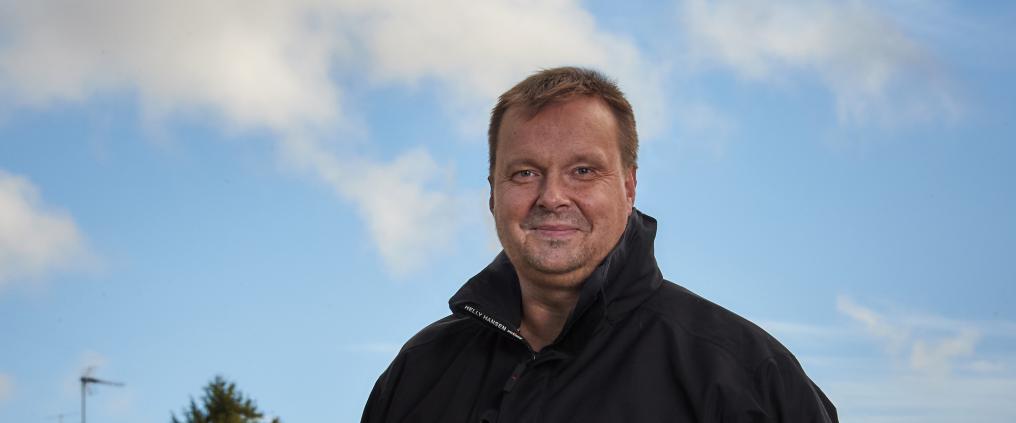“One afternoon, when I had just come home from work, people from Finavia came over to our yard. They asked if they could set up a noise measurement station there, saying that it was a good spot for measuring aircraft noise,” Jari Mäkinen says.
Mäkinen, a manager in a logistics company, lives with his family in the peaceful 1960s suburb of Koivupää, Vantaa. The neighbourhood is a little over half a kilometre away from the edge of Helsinki Airport’s runway 3. During the afternoon rush hour, you can easily spot both departing and arriving aircraft from Mäkinen’s front yard.
Mäkinen is one of the around 25,000 people living in the noise impact area of Helsinki Airport. Controlling aircraft noise is an important part of Finavia’s responsibility: the goal is to reduce the impact of noise to the residents in the surrounding areas.
As part of noise management work, Finavia’s mobile noise measurement station was set up in Mäkinen’s yard. A device weighing 30 kilograms, resembling a large camera tripod, measured noise levels for a period of two weeks to provide additional data about aircraft noise in the vicinity of the airport.
Continuous noise monitoring
Most of the aircraft noise data measured around Helsinki Airport comes from ten measurement stations that constantly monitor noise. They are located under aircraft landing paths around the Helsinki metropolitan area. The measured data is combined with nearby aircraft data provided by radar information from air traffic control. The measured noise data complements calculations that are based on noise figures provided by aircraft manufactures.
The noise data is visible for everyone on a service called WebTrak.
For additional measurements – as well as measurements around other Finnish airports – mobile measurement stations like the one seen at Mäkinen’s yard are used.
“Additional local noise measurements in certain residential areas around the airport can be required in environmental permits. When setting up the mobile measurement station, we look for a suitable house where people are at home. Usually people are happy to receive us,” shares Tuomo Leskelä, an Environmental Engineer at Finavia.
Adjusting to aircraft noise
Mäkinen has almost a lifelong experience of living next to the airport.
“I’ve lived in Koivupää for ten years now – this time around.”
Mäkinen lives in his old childhood home with his partner and two kids, aged 9 and 16. During the afternoon rush hour, the yard is filled with a constant hum, with recognisable sounds of aircraft taking off.
“To be honest, I don’t really pay attention to the sound of aircraft. If I register a louder noise, I may note that okay, the 350 [Finnair’s Airbus A350 XWB] is taking off now. In the mornings and in the evenings, aircraft noise is part of my normal daily cycle,” describes Mäkinen.
Noise impact area of Helsinki Airport has shrunk
Noise area maps shows that the work of Finavia and its partners in controlling aircraft noise has paid off. In 1990, there were 97,000 inhabitants living within the aircraft noise area of Helsinki Airport. In 2017, the number was down to 25,000.
“The noise impact area around Helsinki Airport has become significantly smaller since the 1990s, despite increased air traffic. The most important goal is to have as few people as possible to live within the area of aircraft noise,” Leskelä says.
Aircraft noise has decreased due to technological improvements in aircraft engines and the development of flying methods. Collaboration between Finavia, ANS Finland, airline companies and authorities has been key in decreasing the size of the aircraft noise area.
Flight route planning can reduce noise pollution substantially during take-offs and landings, when air traffic is directed to the least populated areas whenever possible. In addition, most aircraft landings at Helsinki Airport use the continuous descent operations approach, also known as “green landings”. This reduces aircraft noise as well as emissions.
“Finavia also works in close cooperation with municipalities to allow them to take possible noise areas into account when planning new residential areas,” Leskelä concludes.
Read more about Finavia’s noise management.
Watch a video about runway and aircraft noise management at Helsinki Airport.
Follow noise measurement data on WebTrak service.
Watch a video about Finavia’s corporate responsibility – the Sum of Good things.




